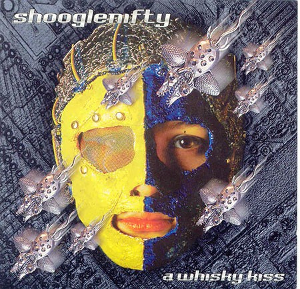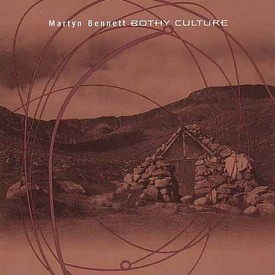
Runrig were a Scottish Celtic rock band formed on the Isle of Skye in 1973. From its inception, the band's line-up included brothers and songwriters Rory MacDonald and Calum MacDonald (percussion). The line-up during most of the 1980s and 1990s, which was the band's most successful period commercially, also included Donnie Munro (vocals), Malcolm Jones (guitar), Iain Bayne (drums), and Pete Wishart (keyboards). Munro left the band in 1997 to pursue a career in politics and was replaced by Bruce Guthro. Wishart left in 2001, also to pursue a career in politics, and was replaced by Brian Hurren. The band released fourteen studio albums, with a number of their songs sung in Scottish Gaelic. At the height of their success during the 1980s and 1990s, Runrig were described by Billboard as one of the "most celebrated" Gaelic language bands in Scotland.

Kathryn Tickell, OBE, DL is an English musician, noted for playing the Northumbrian smallpipes and fiddle.

The Peatbog Faeries are a largely instrumental Celtic fusion band. Formed in 1991, they are based in Dunvegan on the Isle of Skye, Scotland.
Celtic fusion is an umbrella term for any modern music which incorporates influences considered "Celtic", or Celtic music which incorporates modern music. It is a syncretic musical tradition which borrows freely from the perceived "Celtic" musical traditions of all the Celtic nations, as well as from all styles of popular music, it is thus sometimes associated with the Pan-Celtic movement. Celtic fusion may or may not include authentic traditional music from any one tradition under the Celtic umbrella, but its common characteristic is the inspiration by Celtic identity.

Dougie MacLean, OBE is a Scottish singer-songwriter, composer, multi-instrumentalist and record producer. Described by AllMusic as "one of Scotland's premier singer-songwriters", MacLean has performed both under his own name, and as part of multiple folk bands, since the mid 1970s. His most famous pieces include "Caledonia", which is often dubbed Scotland's "unofficial national anthem"; and "The Gael", which became the main theme to the 1992 film The Last of the Mohicans.

A Whisky Kiss is the second studio album by Scottish Celtic fusion band Shooglenifty. After releasing their first album Venus in Tweeds in 1994, the band toured, and then began work on A Whisky Kiss in late 1995. Some of the album's tracks were premiered in early 1996 ahead of its release. The album combines the band's Scottish Celtic music with genres such as worldbeat and techno. The band described the album as "acid croft", whilst one reviewer termed it a unique variation of Celtic rock.
The Scots Trad Music Awards or Na Trads were founded in 2003 by Simon Thoumire to celebrate Scotland's traditional music in all its forms and create a high profile opportunity to bring the music and music industry into the spotlight of media and public attention. Nominations are made by the public and in 2019 over 100,000 public votes were expected across 18 categories.

Mellowosity is the debut studio album by Scottish Celtic fusion group Peatbog Faeries, released in 1996 on Greentrax Recordings. After forming as a vocal-based Celtic rock group in 1994, the duo had settled into becoming an instrumental Celtic fusion group by the release of Mellowosity. The album draws from a wide range of musical styles and influences including jazz, reggae, afrobeat, rock, Eastern music, dub and funk, that are mixed in with the band's traditional Scottish folk/Celtic sound featuring fiddles and bagpipes.

Faerie Stories is the second album by Scottish Celtic fusion group Peatbog Faeries, released in 2001 on Greentrax Recordings. The album was reissued in 2008 as a digipack. The album is large departure from the sound of their début album Mellowosity (1996), and sees the band explore a largely electronic sound mixed with their traditional Celtic fusion sound. Influences of electronic genres such as electronica, house, dubtronica and trip hop, in addition to even dub music and African music can be heard on the album fused with traditional Scottish Celtic music.

Welcome to Dun Vegas is the third album by Scottish Celtic fusion group Peatbog Faeries, released in July 2003 as the first release on the band's own Peatbog Records label. The album was recorded in a cottage on the banks of Pool Roag, near Dunvegan, on the Isle of Skye. Following the electronic-infused Faerie Stories (2001), Dun Vegas was co-produced between Calum MacLean and the band's drummer Iain Copeland. The album is experimental, mixing traditional and modern Celtic music with other genres and styles such as African music and electronica and featuring experimental effects including backwards drumming and a track based around a kitchen cooker timer.

Croftwork is the fourth album by Scottish Celtic fusion group Peatbog Faeries, recorded in Roag on the Isle of Skye, and released in 2005 on the band's own Peatbog Records label. It was released as the label's second album following on from the band's previous album Welcome to Dun Vegas (2003). They recorded the album at Phat Controller Productions on the band's native Isle of Skye.

What Men Deserve To Lose is the fifth album by Scottish Celtic fusion group Peatbog Faeries, recorded at Skye Recording in Roag on the band's native Isle of Skye in 2007, and was commercially released on 16 July 2007 on the band's own label Peatbog Records, though the album had been sold at festivals, and from the band's website, since 22 June 2007. It is the band's first album to feature Graeme Stafford, who brings what the band described as a "dancey" feel to the album.

Bothy Culture is the second studio album by the Scottish Celtic fusion artist Martyn Bennett, released in October 1997 on the Rykodisc label. After winning critical acclaim for his debut album Martyn Bennett (1996), Bothy Culture builds upon that album's mixing of Scottish Celtic music with farther, international folk music styles and contemporary electronic music. The album celebrates and draws upon the music of Bennett's native Gaeldom as well as the music of Islam and Scandinavia, with Bennett finding and emotionally connecting to the similarities between the geographically dispersed styles. It mixes the styles with contemporary electronic music such as breakbeat and drum and bass.
Bongshang are a Scottish band from Shetland, who fuse traditional Shetland and folk styles with rock, funk, electronica and contemporary production techniques. They have been likened to Celtic fusion artists such as Shooglenifty and Martyn Bennett.

Live is the first live album by Scottish celtic fusion band Peatbog Faeries, released in 2009 by Peatbog Records. It is a compilation album of live tracks from two of the band's concerts in their 2008 tour, and is the band's first album to have been released in a digipak.
Jonny Kearney & Lucy Farrell were a contemporary English folk duo. Although they played some traditional songs, most of the songs they sang were their own compositions influenced by the folk tradition, but also songs by other artists such as Bob Dylan, Tom Waits, Cole Porter, Brian Wilson and The Beatles.

Blackhouse is the seventh studio album by Scottish celtic fusion band Peatbog Faeries, released in May 2015 by the band's label Peatbog Records. After recording their acclaimed album Dust (2011), the band played live for the following few years, during which time fiddler Peter Tickell left the band, to be replaced by Ross Couper. As the band had not recorded an album for some years, they returned to record Blackhouse mainly in a cottage in Kilchoan, Ardnamurchan during 2014, although recording continued into 2015. Their first album with Touper, and their first without a brass section since Welcome to Dun Vegas (2003), Blackhouse was produced by Calum MacLean and displays a very eclectic array of genres, fusing the band's Scottish celtic roots with genres such as jazz, funk, reggae, dance and house.

Zoë Bestel is a Scottish singer-songwriter, who describes her music as Nu-Folk. She started learning the Ukulele in 2011 and released her first EP in 2012. Bestel has released two albums, been nominated for the Scottish Alternative Music Awards under the Best Acoustic category and supported artists such as Nathan Connolly of Snow Patrol, Emily Smith, The Paul McKenna Band, The Peatbog Faeries, Erin Rae, Chris Wood, Paul Brady, Steve Tilston and Bella Hardy.

Rachel Newton is a Scottish singer and harpist. As well as playing both acoustic and electric harp she also plays viola, fiddle, piano and harmonium. She performs solo as well as in the bands The Shee, The Furrow Collective and Boreas and was formerly a member of the Emily Portman Trio. She was a member of the Lost Words Spell Songs project and is a co-founder of The Bit Collective, a group campaigning for equality in folk music.
Valtos is an electronic Celtic fusion duo based on the Isle of Skye. Their name comes from the village of the same name, close to Staffin on Skye.
















